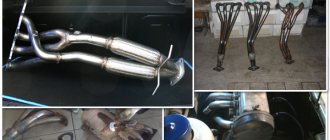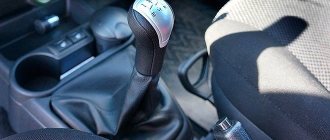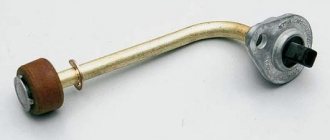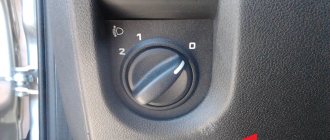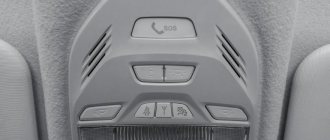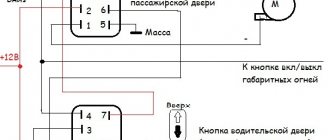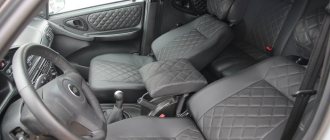Good day to all! Today I decided to talk about such a relative innovation as the GLONASS button. I want to share some thoughts and observations with you.
Despite the fact that ERA GLONASS has been operating in our country for quite a long time, not everyone knows what it is, why it is installed on a car and what the presence of such a button in a car does.
Various news regarding ERA constantly appear, but many of them are not supported by links to official sources. As a result, the news turns into rumors and myths that contribute to destabilization among car owners. Let's try to figure out some of them by answering the main questions.
Trunk Skoda Octavia: choosing the best option
There are various myths and misconceptions among motorists and ordinary car enthusiasts who are just planning to acquire their own vehicle. Moreover, some of them are related to the fact that the government does not give clear answers to the questions posed. Take, for example, the so-called grace period, which was supposed to end on July 1, 2022. After all, as of January 1, 2022, a rule was introduced according to which an ERA must be installed on all vehicles. This applies to cars produced in the country and imported into the Russian Federation.
It was from July 1, 2022 that some kind of permanent order should have been introduced. But somehow they forgot about it, because when the first day arrived, no innovations appeared. The bill was not published anywhere, the procedure remained the same.
As a result, it turned out that the grace period was extended for another year. As you understand, nothing has changed since July 2022.
If you have more recent and officially confirmed information, be sure to write in the comments.
As for the rules for residents of the Far East, cities such as Vladivostok, there are benefits for cars from Japan with right-hand drive. In fact, the rules about the GLONASS ERA do not apply to them. This applies to the import of right-hand drive passenger cars, and specifically used ones. Residents of the Far East, as well as those who move there for permanent residence, can import 1 right-hand drive car, which belongs to the M1 category, once a year. At the same time, they do not need to install GLONASS equipment in the car. The presence of ERA is checked by customs.
There are many rumors that the rules have been canceled, or that every car owner, regardless of the year of manufacture of the car, will have to buy and install an electronic control unit. And the cost of the kit is about 30 thousand rubles. But let's start from official information.
Foreign analogues
European Union
What is acs on a car and how does the automatic braking system work?
Since 2001, the countries of the European Union have been developing the eCall program, according to which in 2015 all vehicles sold in the territory of the commonwealth must be equipped with navigation and communication aids that are triggered in the event of an accident, after which information about the location of the vehicle is transmitted to number 112 via GSM communication channels. the nearest control center. In countries such as Germany, road trains with a carrying capacity of over 12 tons have been equipped with such devices since 2005, and in Sweden - trucks weighing over 3.5 tons.
To further promote the eCall program, the European Commission created the EeIP (European eCall Implementation Platform) coordination council in 2004, whose tasks also include interaction with ERA-GLONASS. To test the eCall infrastructure within the European Union and Russia, a consortium of industry representatives HeERO (Harmonized eCall European Pilot) was created in 2011.
Kazakhstan
An analogue of the ERA-GLONASS system called “EVAC” is being developed in Kazakhstan - an emergency call in case of accidents and disasters
. It will operate using signals from GPS and GLONASS satellite navigation systems. It is planned to equip passenger cars weighing over 2.5 tons, buses, trucks and special vehicles for transporting dangerous goods with the on-board system from 2016, and from 2022 - all other vehicles.
Japan
Since the mid-1980s, an intelligent transport system has been launched on all roads in the country, designed to fully automate traffic management. All vehicles began to be equipped with special on-board navigation and communication equipment, which provides control over the location and condition of the vehicle. The transmission of information and control signals, as well as duplex communication with the driver, is carried out by a quick response dispatch service called ECall. As a result of the successful operation of the system, mortality on Japanese roads has decreased significantly, in 2009 it amounted to 5 thousand people. The country's authorities plan to reduce the death toll to zero.
USA
Since 2001, the country's authorities have implemented the E911 project, with the help of which data on the location of the phone is automatically transmitted when calling the rescue service. A continuation of the development of the project was the introduction of the NG9-1-1 program since 2006, according to which every victim has the opportunity to use any means of communication to connect with the rescue service operator, who in turn can receive location data from landline and mobile phones, as well as automatic sensors triggered in case of accidents. In 2010, the system was tested and began to be implemented everywhere.
Brazil
In Brazil, the state project SIMRAV is being implemented - a comprehensive system for monitoring and registering vehicles
. Initially, the service was created as an anti-theft system, since the country ranks first in the world in vehicle thefts. It was planned to equip all cars assembled in Brazil and imported with user terminals from 2013, while the launch of the system was postponed 8 times before.
UAE
Starting in 2022, new models of all vehicles arriving in the UAE must be equipped with an eCall system in accordance with the standards of the UAE's national Telecommunications, Information Technology and Mass Communications Authority (ESMA).
Rating of the most stolen cars in Russia: complete list of models
It is important to consider that this applies not only to cars produced by domestic enterprises such as AvtoVAZ. The law applies to all vehicles imported and sold on the Russian market. With its help, it is planned to speed up the response of various emergency services in the event of an accident. It also simplifies communication between the driver and rescuers, firefighters, police, ambulance, etc. As if everything is done for the benefit of the drivers. But not everyone is positive about this innovation. This is largely due to the fact that the price of a car increases, since the cost of the system is included in the price tag of the car.
The driver himself sees only the SOS button in the car, which lights up red when activated. All the filling is hidden. In fact, the system is quite complex, and its installation causes certain difficulties for automakers.
The system includes several modules. They are responsible for relaying emergency messages to the right services.
The standard ERA consists of:
- GLONASS navigation module;
- GPS navigation module;
- modem analogue of a standard SIM card;
- backup power supply;
- antennas;
- microphone;
- dynamics;
- protective housing.
Depending on what kind of machine it is, the system can be located in different places. There are certain standards that require installation to be carried out in such a way as to minimize potential damage from severe impacts.
The automaker decides where to install the module, but is still obliged to adhere to accepted standards.
What is ERA-GLONASS
The ERA-GLONASS emergency warning system was developed and implemented on the territory of the Russian Federation not so long ago: it was officially put into operation in 2015.
ERA-GLONASS devices can be installed in any car
The in-vehicle emergency call device is designed to automatically notify about an accident. In the EU countries, an analogue of the Russian development is the eCall system, which has managed to prove itself in the best possible way. Instant information about road accidents saved many lives thanks to the quick response of special services.
Despite the fact that ERA-GLONASS appeared in Russia recently, the advantages of its installation were highly appreciated by ambulance workers and other rescue services. The driver or any other person nearby just needs to press the SOS button located in an accessible place. After this, the coordinates of the accident site will be automatically transmitted to the control center, and then to the nearest helpline.
Towbar for Skoda Karoq: which one to buy, installation details
There is a rule according to which the button should be placed in such a way as to minimize deformation and damage to the system itself during impacts and collisions. Therefore, additional calculations of side and frontal impacts are required. At the same time, it should be possible to reach the button while sitting in the driver’s seat with a seat belt fastened. By the way, the ERA forced automakers to re-conduct crash tests, but in Russia. Even if the car received the highest score according to Euro NCAP, this will not avoid repeated testing necessary to check the stability of the ERA.
In reality, the button is most often installed in the area of the rearview mirror, as well as to the left or right of the steering column.
GOST also stipulates the need to use protective mechanisms to prevent accidental calls to services. Therefore, the button must be covered with a folding panel.
Incomplete coverage
“It’s too early to say that the system has justified itself. Its potential capabilities are good, but it does not yet completely cover the territory of Russia. And the number of rapid response centers is not enough,” Igor Morzharetto told Izvestia.
Indeed, in the territory where 112 does not work, ERA-GLONASS operators have to call the duty station of the Ministry of Internal Affairs using standard communication channels, that is, simply by telephone.
“This may cause delays in call transfer. Also in this case, it is not possible to transmit coordinates to emergency services. After receiving a call, in accordance with the current regulations of the Ministry of Internal Affairs, the emergency services operator is obliged to clarify the location and all details of the incident,” said the press service of JSC GLONASS.
Today in Russia, constant automated information interaction between GAIS “ERA-GLONASS” and System-112 is already provided in 54 constituent entities of the Russian Federation, with 13 being implemented this year. It is expected that by the end of 2022 the number of such entities will increase to 60.
“ERA-GLONASS transmits a package of messages, coordinates. Imagine that we are operators and calling an emergency service. So many degrees of northern latitude, so many longitudes. And if it’s in the area of the 175th kilometer of the Ural highway,” asked the editor-in-chief of “Behind the Wheel” Maxim Kadakov. According to him, the system is still in its initial phase.
The airbag light is on: reasons, how to clear the error
Now a little about how to use the ERA GLONASS system. In fact, the instructions will be present in the documentation for the machine upon purchase, so I advise you to simply study this manual and strictly follow it.
The system operates in 2 modes.
What is it for?
The SOS button in ERA GLONASS is provided for manually calling the operator and transmitting information about the accident to the operator at the control center. After receiving the application, the specialist can call emergency vehicles. The presence of an SOS key is useful when the system does not work for some reason, and the driver himself wants to inform special services about a force majeure situation.
What does a flashing yellow traffic light mean: violation and fine
- Auto. Automatic mode is activated in situations where a severe accident occurs. After a collision, the system creates a VIN code that includes information about the car, coordinates, speed, direction, number of passengers, etc. This data is transmitted via the mobile Internet of any network that is currently available. The message itself has little weight, so even with poor communication, the probability of transmitting information is very high. When it is not possible to connect to the Internet, the data is sent in the form of SMS;
- Manual. Here the driver himself presses the corresponding button, which leads to activation of the system. If necessary, you can directly from the car via speakerphone using the speaker and built-in microphone to contact the operator, tell about the incident, call a group, etc.
When transmitting information, regardless of the method, the operator must first try to contact the driver. If this can be done, all additional information is learned through the driver. When the driver does not respond, a team of rescuers and ambulances arrives at the scene.
Certain questions may be raised by the fact that ERA finds out about the number of passengers in the car. But this is relatively accurate information, since it is determined by the number of seat belts fastened. When the passenger is not fastened, the system will not be able to determine the fact that he is in the vehicle.
Is it necessary to install a button in 2022?
You won’t be able to install the help button yourself, even if you are an excellent auto mechanic with a lot of experience behind you. Since installing this system requires not only knowledge of the technical side of the process, but also the presence of licensed authority.
System installation includes the following steps:
- Installation of an emergency response system module in case of accidents.
- Installing the SOS button.
- Connecting the installed equipment to the vehicle system and to the help center.
- Configuring installed devices.
- The final stage is testing the installed ERA-GLONASS system.
How to glue carbon film onto car parts with your own hands
I would like to ask this question to you, our dear readers. Be sure to write your opinion in the comments.
I would like to add one more thing. No one is talking about this officially, but many experts agree that this is how it will end up. We are talking about using the GLONASS ERA as a means of recording offenses in the form of speeding. Some experts are confident that in a couple of years GLONASS will transmit information to the traffic police, and drivers will begin to receive chain letters with fines in those areas where there are no traffic police posts, surveillance cameras, or radars. Whether this is true or not, time will tell.
Thank you all for your attention! Be sure to subscribe to our website, leave comments, ask relevant questions and tell your friends about us!
ERA-GLONASS
The name of the installation is an abbreviation: ERA stands for “Emergency Response to Accidents”, and GLONASS stands for “Global Navigation Satellite System”.
ERA-GLONASS
The satellite constellation includes 24 spacecraft and was conceived as a response to the GPS system. The main purpose of GLONASS is navigation, both in the civilian and military spheres. There are three main installation elements:
- Satellites.
- Ground stations.
- Receivers.
The system works as follows:
- The spacecraft determines its location - for this, the satellite sends signals to ground stations and calculates its position relative to them.
- The device sends a signal to Earth with information about its position and the time the message was sent.
- The receiver receives signals from several spacecraft, determining its location relative to them. The process requires at least four satellites.
What kind of system is this
The most innovative use of the satellite constellation is the ERA system. The device is almost invisible in the car - a small box with a panic button blinking red and green. The device is designed to save lives in road accidents.
On a note. It is not necessary to press the GLONASS panic button in the event of an accident - during a collision or rollover, the device itself will send an alarm signal.
Development and implementation
The idea of creating an emergency response system for road accidents first appeared in 2009. According to studies, the high mortality rate on the roads was primarily a consequence of the late arrival of the ambulance service. Prompt transmission of a signal to emergency services is the installation’s primary task.
The system was first launched in 2013 as an experiment. First of all, public transport – minibuses and buses – were equipped with the devices.
At the beginning of the experiment, ERA was introduced in 15 regions of Russia, however, based on positive feedback, after 4 months the installation was already used by 63 constituent entities of the Russian Federation. Since the beginning of 2015, the system has been put into commercial operation.
↑ Manual emergency call of the operator on Lada Vesta
A manual request can be performed with the engine running, ignition on and off. During the autonomous period, its own battery is used. The system is operational for 3 days in the absence of ignition.
The driver must press the emergency call button and not release it for at least 2 seconds. The backlight turns white and then starts flashing red. The emergency warning system is launched: communication with satellite navigators is carried out, the nature of the vehicle’s movement, the position of the driver and passengers in the cabin (the condition of seat belts and airbags) are determined.
Then the coordinates of the vehicle's location are determined. The received data, as well as information about the VIN, number, color of the car, availability and type of fuel are transmitted to the operator via the Internet or mobile phone.
Within a few seconds after the call, a call is received from the ERA-GLONASS contact center. The operator clarifies whether the call is false, what problems have arisen, gives instructions on further actions and, if necessary, transmits data to the line “112”, 02, 03. During the entire voice communication, the key backlight glows without interruption.
Attention! To cancel a call, press the key again for 2 seconds until it goes out.
When calling the operator, report a false call.
Development and implementation[ edit
The development of the system was carried out within the framework of a project approved by the Commission under the President of the Russian Federation for the modernization and technological development of the Russian economy (clause 1 of the minutes of the Commission meeting dated October 28, 2009 No. 5). During the implementation of the project, the infrastructure of the ERA-GLONASS system was deployed in 83 constituent entities of the Russian Federation, interfaced with systems-112 and emergency operational services, as well as a number of other government systems, a set of national technical standards was approved, and the Federal Law “On the State Automated Information System” was adopted "ERA-GLONASS" [6], which came into force on January 1, 2014.
Initially (2009-2012) it was developed by PJSC Navigation Information Systems [7], then the GLONASS Non-Profit Partnership was identified as the project executor [8].
On the territory of the Russian Federation, telephone codes 941-949 have been reserved and the first series of numbers (941-111-1ххх) have been allocated for communication with emergency information reception centers. Contact activities are organized by the subsidiary Rostelecom Contact Center (ZAO MC NTT) [9]
In July 2013, the system was put into trial operation in 15 regions of Russia, and comprehensive tests were carried out in 63 Russian regions in October of the same year [10]. In December 2013, the system was fully deployed throughout Russia. On January 1, 2015, the system was put into commercial operation [11].
The first production car equipped with the ERA-GLONASS system was the Lada Vesta [12].
The announced cost of on-board equipment in 2013 is 3,000 rubles; there will be no subscription fee for using the system [13]. For an additional fee, it will be possible to provide additional services: tachograph functions, remote diagnostics of the vehicle condition, traffic management system, security and search systems.
On July 3, 2015, by decree of the President of the Russian Federation, the GLONASS Joint Stock Company was created, 100% of the shares owned by the state, as the sole operator of the ERA-GLONASS system [14].
The compatibility and interchangeability of equipment from Russian and European manufacturers was confirmed in a series of field tests conducted in 2011-2012. [15] . It is also planned to be compatible with similar services that will be created in the countries of the Eurasian Economic Union [16].
The possibility of combining ERA-GLONASS with the existing COSPAS-SARSAT rescue system is being considered [17]. In remote areas not covered by cellular communications, in the future it is planned to make contact with the system using the Gonets satellite constellation [17].
The possibility of providing the police with such capabilities as remote shutdown of the car engine and automatic detection of entry into the oncoming lane is being considered [18].
Due to confusion in the legislation of the Russian Federation, since January 2022, it has become impossible for drivers of foreign cars to run their business: customs did not allow cars that did not have GLONASS through. This caused protests in the Far East, where only two agents (appearing in March 2022) and one GLONASS testing laboratory operated [19].
In April 2022, the Ruselectronics holding of the Rostec state corporation presented a new design of the Era-GLONASS terminal with new functions [20].
What information does the system capture?
Since the ERA-GLONASS system can turn on independently in necessary situations, in order to provide proper assistance it is necessary to know some parameters of the damaged vehicle. In the event that the vehicle owner cannot provide this data, the system independently transmits it to the dispatcher:
- Vehicle location.
- Number of passengers. To do this, it is necessary that each passenger wear a seat belt, since the system counts the number of people by the number of belts fastened.
- Technical side of the accident: overload parameters and the last maximum speed before the accident.
- Additional basic information: car number, model, color and type of fuel (gas or gasoline).
Some people are suspicious of such systems that read their location and send data to some centers. But, firstly, the ERA-GLONASS system does not constantly “monitor” you, but only when the shock sensors are triggered and force the navigation system to turn on and send data so that specialized help can come to you. Secondly, it’s worth thinking about the fact that if this system doesn’t “monitor” you around the clock, then maybe you should put aside your worries and understand that ERA-GLONASS can save your life when no one nearby refuses.
Childbirth online
Contact center operators had the opportunity to attend births live. The story took place at the end of summer in the Republic of Mordovia, and the operator could not immediately understand what was going on - at first a man and a woman were talking loudly to each other, then there were screams and, finally, a child’s cry.
It turned out that the family was going to the maternity hospital, which was about 50 kilometers away, but the birth began quickly, right in the car.
The operators found the hospital in the nearest village, which was less than 5 km away, and remained in touch, reassuring the new parents. In addition, they alerted the hospital's medical staff and asked them to prepare to welcome the newborn.
ERA of Mercy: GLONASS saved a life in the mountains of Dagestan A burst tire led to a terrible accident
